Loading AI tools
Total eclipse From Wikipedia, the free encyclopedia
A total solar eclipse occurred at the Moon's descending node of orbit on Wednesday, December 23, 1908,[1][2][3][4] with a magnitude of 1.0024. It was a hybrid event, with only a fraction of its path as total, and longer sections at the start and end as an annular eclipse. A solar eclipse occurs when the Moon passes between Earth and the Sun, thereby totally or partly obscuring the image of the Sun for a viewer on Earth. A total solar eclipse occurs when the Moon's apparent diameter is larger than the Sun's, blocking all direct sunlight, turning day into darkness. Totality occurs in a narrow path across Earth's surface, with the partial solar eclipse visible over a surrounding region thousands of kilometres wide. Occurring about 3.1 days before perigee (on December 26, 1908, at 13:30 UTC), the Moon's apparent diameter was larger.[5]
Annularity was visible from Chile, Argentina, Uruguay and southern Brazil, while totality was visible only from southern Atlantic Ocean with no land. A partial eclipse was visible for parts of northern South America, most of North America, the Caribbean, West Africa, North Africa, and Western Europe.
Shown below are two tables displaying details about this particular solar eclipse. The first table outlines times at which the moon's penumbra or umbra attains the specific parameter, and the second table describes various other parameters pertaining to this eclipse.[6]
| Event | Time (UTC) |
|---|---|
| First Penumbral External Contact | 1908 December 23 at 09:06:26.9 UTC |
| First Umbral External Contact | 1908 December 23 at 10:10:43.8 UTC |
| First Central Line | 1908 December 23 at 10:11:10.4 UTC |
| Greatest Duration | 1908 December 23 at 10:11:10.4 UTC |
| First Umbral Internal Contact | 1908 December 23 at 10:11:37.1 UTC |
| Greatest Eclipse | 1908 December 23 at 11:44:27.5 UTC |
| Equatorial Conjunction | 1908 December 23 at 11:49:14.3 UTC |
| Ecliptic Conjunction | 1908 December 23 at 11:49:45.9 UTC |
| Last Umbral Internal Contact | 1908 December 23 at 13:17:16.8 UTC |
| Last Central Line | 1908 December 23 at 13:17:40.9 UTC |
| Last Umbral External Contact | 1908 December 23 at 13:18:04.9 UTC |
| Last Penumbral External Contact | 1908 December 23 at 14:22:20.6 UTC |
| Parameter | Value |
|---|---|
| Eclipse Magnitude | 1.00243 |
| Eclipse Obscuration | 1.00486 |
| Gamma | –0.49845 |
| Sun Right Ascension | 18h05m35.3s |
| Sun Declination | -23°26'42.1" |
| Sun Semi-Diameter | 16'15.7" |
| Sun Equatorial Horizontal Parallax | 08.9" |
| Moon Right Ascension | 18h05m23.9s |
| Moon Declination | -23°55'54.7" |
| Moon Semi-Diameter | 16'04.3" |
| Moon Equatorial Horizontal Parallax | 0°58'59.0" |
| ΔT | 9.1 s |
This eclipse is part of an eclipse season, a period, roughly every six months, when eclipses occur. Only two (or occasionally three) eclipse seasons occur each year, and each season lasts about 35 days and repeats just short of six months (173 days) later; thus two full eclipse seasons always occur each year. Either two or three eclipses happen each eclipse season. In the sequence below, each eclipse is separated by a fortnight.
| December 7 Ascending node (full moon) | December 23 Descending node (new moon) |
|---|---|
 |  |
| Penumbral lunar eclipse Lunar Saros 114 | Hybrid solar eclipse Solar Saros 140 |
This eclipse is a member of a semester series. An eclipse in a semester series of solar eclipses repeats approximately every 177 days and 4 hours (a semester) at alternating nodes of the Moon's orbit.[7]
The partial solar eclipses on February 23, 1906 and August 20, 1906 occur in the previous lunar year eclipse set.
| Solar eclipse series sets from 1906 to 1909 | ||||||
|---|---|---|---|---|---|---|
| Ascending node | Descending node | |||||
| Saros | Map | Gamma | Saros | Map | Gamma | |
| 115 | July 21, 1906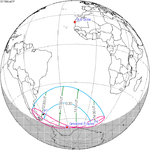 Partial |
−1.3637 | 120 | January 14, 1907 Total |
0.8628 | |
| 125 | July 10, 1907 Annular |
−0.6313 | 130 | January 3, 1908 Total |
0.1934 | |
| 135 | June 28, 1908 Annular |
0.1389 | 140 | December 23, 1908 Hybrid |
−0.4985 | |
| 145 | June 17, 1909 Hybrid |
0.8957 | 150 | December 12, 1909 Partial |
−1.2456 | |
This eclipse is a part of Saros series 140, repeating every 18 years, 11 days, and containing 71 events. The series started with a partial solar eclipse on April 16, 1512. It contains total eclipses from July 21, 1656 through November 9, 1836; hybrid eclipses from November 20, 1854 through December 23, 1908; and annular eclipses from January 3, 1927 through December 7, 2485. The series ends at member 71 as a partial eclipse on June 1, 2774. Its eclipses are tabulated in three columns; every third eclipse in the same column is one exeligmos apart, so they all cast shadows over approximately the same parts of the Earth.
The longest duration of totality was produced by member 11 at 4 minutes, 10 seconds on August 12, 1692, and the longest duration of annularity will be produced by member 53 at 7 minutes, 35 seconds on November 15, 2449. All eclipses in this series occur at the Moon’s descending node of orbit.[8]
| Series members 18–39 occur between 1801 and 2200: | ||
|---|---|---|
| 18 | 19 | 20 |
 October 29, 1818 |
 November 9, 1836 |
 November 20, 1854 |
| 21 | 22 | 23 |
 November 30, 1872 |
 December 12, 1890 |
 December 23, 1908 |
| 24 | 25 | 26 |
 January 3, 1927 |
 January 14, 1945 |
 January 25, 1963 |
| 27 | 28 | 29 |
 February 4, 1981 |
 February 16, 1999 |
 February 26, 2017 |
| 30 | 31 | 32 |
 March 9, 2035 |
 March 20, 2053 |
 March 31, 2071 |
| 33 | 34 | 35 |
 April 10, 2089 |
 April 23, 2107 |
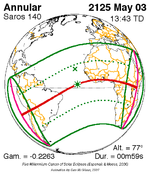 May 3, 2125 |
| 36 | 37 | 38 |
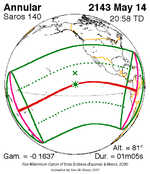 May 14, 2143 |
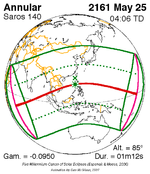 May 25, 2161 |
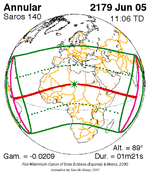 June 5, 2179 |
| 39 | ||
 June 15, 2197 | ||
The metonic series repeats eclipses every 19 years (6939.69 days), lasting about 5 cycles. Eclipses occur in nearly the same calendar date. In addition, the octon subseries repeats 1/5 of that or every 3.8 years (1387.94 days). All eclipses in this table occur at the Moon's descending node.
| 22 eclipse events between March 5, 1848 and July 30, 1935 | ||||
|---|---|---|---|---|
| March 5–6 | December 22–24 | October 9–11 | July 29–30 | May 17–18 |
| 108 | 110 | 112 | 114 | 116 |
 March 5, 1848 |
 July 29, 1859 |
 May 17, 1863 | ||
| 118 | 120 | 122 | 124 | 126 |
 March 6, 1867 |
 December 22, 1870 |
 October 10, 1874 |
 July 29, 1878 |
 May 17, 1882 |
| 128 | 130 | 132 | 134 | 136 |
 March 5, 1886 |
 December 22, 1889 |
 October 9, 1893 |
 July 29, 1897 |
 May 18, 1901 |
| 138 | 140 | 142 | 144 | 146 |
 March 6, 1905 |
 December 23, 1908 |
 October 10, 1912 |
 July 30, 1916 |
 May 18, 1920 |
| 148 | 150 | 152 | 154 | |
 March 5, 1924 |
 December 24, 1927 |
 October 11, 1931 |
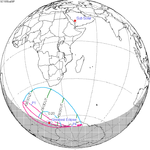 July 30, 1935 | |
This eclipse is a part of a tritos cycle, repeating at alternating nodes every 135 synodic months (≈ 3986.63 days, or 11 years minus 1 month). Their appearance and longitude are irregular due to a lack of synchronization with the anomalistic month (period of perigee), but groupings of 3 tritos cycles (≈ 33 years minus 3 months) come close (≈ 434.044 anomalistic months), so eclipses are similar in these groupings.
The partial solar eclipses on December 7, 2170 (part of Saros 164) and November 7, 2181 (part of Saros 165) are also a part of this series but are not included in the table below.
| Series members between 1801 and 2105 | ||||
|---|---|---|---|---|
 September 28, 1810 (Saros 131) |
 August 27, 1821 (Saros 132) |
 July 27, 1832 (Saros 133) |
 June 27, 1843 (Saros 134) |
 May 26, 1854 (Saros 135) |
 April 25, 1865 (Saros 136) |
 March 25, 1876 (Saros 137) |
 February 22, 1887 (Saros 138) |
 January 22, 1898 (Saros 139) |
 December 23, 1908 (Saros 140) |
 November 22, 1919 (Saros 141) |
 October 21, 1930 (Saros 142) |
 September 21, 1941 (Saros 143) |
 August 20, 1952 (Saros 144) |
 July 20, 1963 (Saros 145) |
 June 20, 1974 (Saros 146) |
 May 19, 1985 (Saros 147) |
 April 17, 1996 (Saros 148) |
 March 19, 2007 (Saros 149) |
 February 15, 2018 (Saros 150) |
 January 14, 2029 (Saros 151) |
 December 15, 2039 (Saros 152) |
 November 14, 2050 (Saros 153) |
 October 13, 2061 (Saros 154) |
 September 12, 2072 (Saros 155) |
 August 13, 2083 (Saros 156) |
 July 12, 2094 (Saros 157) |
 June 12, 2105 (Saros 158) | ||
This eclipse is a part of the long period inex cycle, repeating at alternating nodes, every 358 synodic months (≈ 10,571.95 days, or 29 years minus 20 days). Their appearance and longitude are irregular due to a lack of synchronization with the anomalistic month (period of perigee). However, groupings of 3 inex cycles (≈ 87 years minus 2 months) comes close (≈ 1,151.02 anomalistic months), so eclipses are similar in these groupings.
| Series members between 1801 and 2200 | ||
|---|---|---|
 February 21, 1822 (Saros 137) |
 February 1, 1851 (Saros 138) |
 January 11, 1880 (Saros 139) |
 December 23, 1908 (Saros 140) |
 December 2, 1937 (Saros 141) |
 November 12, 1966 (Saros 142) |
 October 24, 1995 (Saros 143) |
 October 2, 2024 (Saros 144) |
 September 12, 2053 (Saros 145) |
 August 24, 2082 (Saros 146) |
 August 4, 2111 (Saros 147) |
 July 14, 2140 (Saros 148) |
 June 25, 2169 (Saros 149) |
 June 4, 2198 (Saros 150) |
|
Seamless Wikipedia browsing. On steroids.
Every time you click a link to Wikipedia, Wiktionary or Wikiquote in your browser's search results, it will show the modern Wikiwand interface.
Wikiwand extension is a five stars, simple, with minimum permission required to keep your browsing private, safe and transparent.